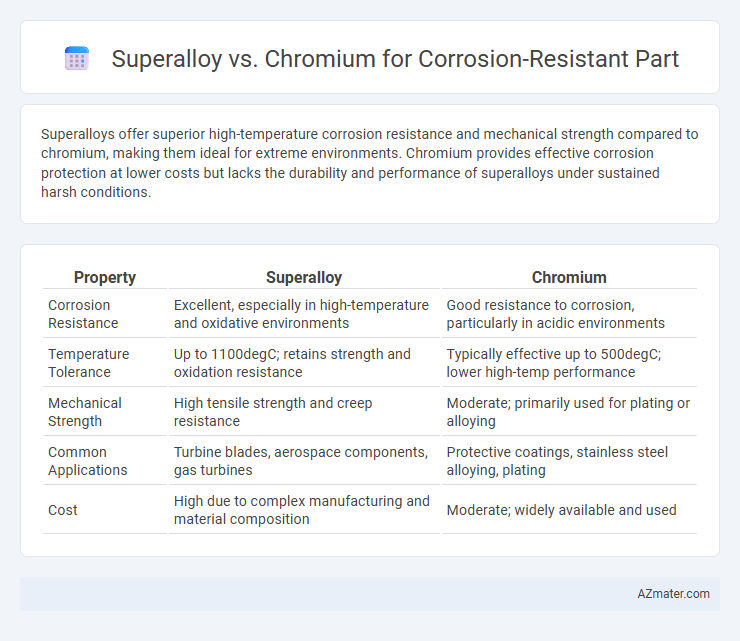Superalloys offer superior high-temperature corrosion resistance and mechanical strength compared to chromium, making them ideal for extreme environments. Chromium provides effective corrosion protection at lower costs but lacks the durability and performance of superalloys under sustained harsh conditions.
Table of Comparison
| Property | Superalloy | Chromium |
|---|---|---|
| Corrosion Resistance | Excellent, especially in high-temperature and oxidative environments | Good resistance to corrosion, particularly in acidic environments |
| Temperature Tolerance | Up to 1100degC; retains strength and oxidation resistance | Typically effective up to 500degC; lower high-temp performance |
| Mechanical Strength | High tensile strength and creep resistance | Moderate; primarily used for plating or alloying |
| Common Applications | Turbine blades, aerospace components, gas turbines | Protective coatings, stainless steel alloying, plating |
| Cost | High due to complex manufacturing and material composition | Moderate; widely available and used |
Introduction to Corrosion-Resistant Materials
Superalloys exhibit exceptional corrosion resistance due to their complex composition, including high levels of nickel, cobalt, and chromium, which form stable oxide layers that inhibit degradation. Chromium, a key element in stainless steels and other alloys, enhances corrosion resistance by creating a passive oxide film that protects surfaces from oxidative and chemical damage. Selecting between superalloy and chromium-based materials depends on specific environmental factors, such as temperature, chemical exposure, and mechanical stress, to ensure optimal durability and performance in corrosive applications.
Understanding Superalloys: Composition and Properties
Superalloys are advanced corrosion-resistant materials primarily composed of nickel, cobalt, or iron, combined with elements like chromium, aluminum, and titanium to enhance strength and oxidation resistance at high temperatures. Unlike pure chromium, which offers excellent corrosion resistance but limited mechanical strength, superalloys provide a balanced combination of corrosion resistance, high-temperature stability, and mechanical durability. Their complex microstructures, including gamma prime precipitates, enable superior performance in extreme environments such as turbine blades and chemical processing equipment.
Characteristics of Chromium in Corrosion Resistance
Chromium exhibits exceptional corrosion resistance due to its ability to form a stable, adherent oxide layer (Cr2O3) that protects the underlying metal from oxidation and environmental damage. This passive oxide film regenerates quickly when damaged, maintaining long-term protection against rust and corrosion in harsh environments. Its high resistance to acidic and alkaline conditions makes chromium a preferred choice for coatings and alloying in corrosion-resistant parts.
Key Differences: Superalloy vs Chromium
Superalloys exhibit superior corrosion resistance due to their complex composition, including nickel, cobalt, and chromium, which enhances durability in high-temperature and oxidative environments. Chromium, as a pure element or simple alloying addition, provides excellent surface oxidation protection but lacks the mechanical strength and thermal stability inherent in superalloys. The key differences lie in superalloys' multi-element engineering for performance under extreme conditions, whereas chromium primarily offers corrosion resistance through passivation on less demanding applications.
Performance Comparison in Harsh Environments
Superalloys exhibit superior corrosion resistance compared to chromium in harsh environments due to their complex composition, including nickel, cobalt, and molybdenum, which enhance oxidation and pitting resistance. While chromium provides a protective oxide layer that significantly reduces surface corrosion, superalloys maintain structural integrity under extreme temperatures and aggressive chemical exposure. Performance metrics such as corrosion rate, tensile strength, and oxidation resistance consistently show that superalloys outperform pure chromium in applications like aerospace, chemical processing, and marine industries.
Cost Analysis: Superalloy Versus Chromium
Superalloys typically incur higher upfront costs than chromium due to their complex manufacturing processes and the use of expensive elements like nickel and cobalt. Chromium coatings, while more affordable initially, may require more frequent maintenance or replacement in highly corrosive environments, potentially increasing long-term expenses. A detailed cost analysis reveals that despite higher initial investment, superalloys offer superior durability and reduced lifecycle costs compared to chromium-based corrosion-resistant parts.
Application Areas: Matching Materials to Use-Cases
Superalloys excel in high-temperature, corrosive environments like aerospace turbine blades and chemical processing equipment due to their exceptional heat resistance and oxidation durability. Chromium, often used in coatings and stainless steel formulations, provides effective corrosion resistance in moderate-temperature applications such as automotive exhaust systems and food processing machinery. Selecting between superalloy and chromium depends on specific operational conditions, including temperature ranges and exposure to aggressive chemicals.
Durability and Longevity Under Corrosive Conditions
Superalloys, composed primarily of nickel, cobalt, or iron-based materials, exhibit superior durability and longevity under corrosive conditions due to their stable oxide layers and resistance to high-temperature oxidation. Chromium, often utilized in stainless steel alloys, provides significant corrosion resistance through the formation of a passive chromium oxide film but tends to be less effective in extreme environments compared to superalloys. The enhanced mechanical strength and oxidation resistance of superalloys make them more suitable for long-term applications in harsh chemical and thermal settings.
Sustainability and Environmental Impact
Superalloys offer superior corrosion resistance and durability compared to chromium, reducing the frequency of part replacements and lowering waste generation in industrial applications. The extended lifespan of superalloy components supports sustainability by minimizing resource extraction and energy consumption associated with manufacturing new parts. In contrast, chromium mining and processing pose significant environmental risks due to toxic byproducts, making superalloys a more environmentally responsible choice for corrosion-resistant parts.
Final Recommendations for Material Selection
Superalloys provide superior high-temperature strength and excellent corrosion resistance, making them ideal for aerospace and industrial applications exposed to extreme environments. Chromium, while cost-effective and offering good corrosion resistance in less aggressive conditions, lacks the mechanical robustness of superalloys under thermal stress. For critical components requiring long-term durability and resistance to both oxidation and corrosion, selecting a nickel-based superalloy is recommended over chromium to ensure optimal performance and lifespan.

Infographic: Superalloy vs Chromium for Corrosion-Resistant Part
 azmater.com
azmater.com